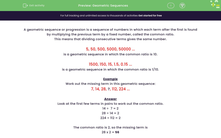A geometric sequence or progression is a sequence of numbers in which each term after the first is found by multiplying the previous term by a fixed number, called the common ratio.
This means that dividing consecutive terms gives the same number.
5, 50, 500, 5000, 50000 ...
is a geometric sequence in which the common ratio is 10.
1500, 150, 15, 1.5, 0.15 ...
is a geometric sequence in which the common ratio is 1/10.
Example
Work out the missing term in this geometric sequence:
7, 14, 28, ?, 112, 224 ...
Answer
Look at the first few terms in pairs to work out the common ratio.
14 ÷ 7 = 2
28 ÷ 14 = 2
224 ÷ 112 = 2
The common ratio is 2, so the missing term is
28 x 2 = 56
Let's practise this in the following questions.








